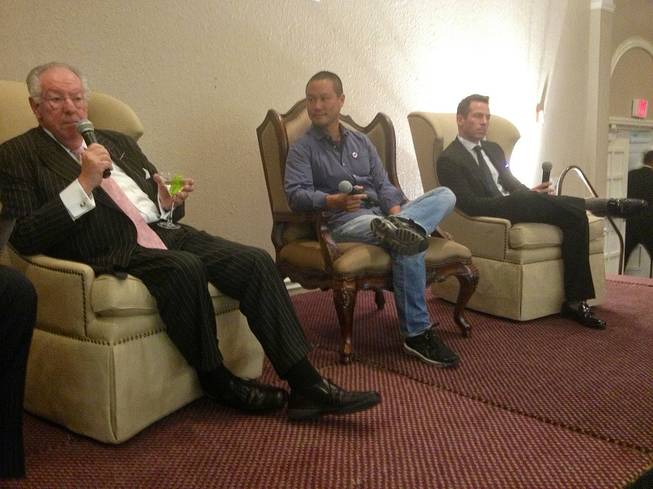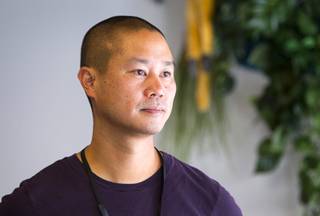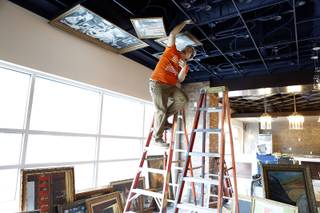
Former Las Vegas Mayor Oscar Goodman, from left, is shown at a forum discussion with Zappos CEO Tony Hsieh and Seth Schorr, head of the Downtown Grand, Monday, Oct. 21, 2013.
Monday, Oct. 21, 2013 | 5:45 p.m.
Tony Hsieh came off as a modest voice of calm amid former Las Vegas Mayor Oscar Goodman’s outspoken ex-mob-lawyer-turned-mayor persona, as both addressed questions about downtown’s rebirth at a luncheon today.
With Seth Schorr, who will open Downtown Grand, formerly the Lady Luck, in a week, they talked at a forum, sponsored by the Review-Journal, in the Plaza around noon today.
“I think it’s come a lot further a lot quicker than I had envisioned,” Goodman said of downtown’s redevelopment.
It was only after he became mayor, even after having worked downtown as a lawyer for decades, did he notice the blight, he said. “I saw a downtown that was lethargic, that had no energy whatsoever and I knew I wanted to see happen.”
He saw its rebirth would hinge on culture, a medical community and a major league sports team. The Smith Center for the Performing Arts helped fulfill the cultural aspect, the Cleveland Clinic Lou Ruvo Center for Brain Health is the first rung in the medical community; and he’s still awaiting a sports team.
Goodman admitted, though, “I had built a house of cards that could have fallen … but when Tony Hsieh came along — the vision became more secure."
Hsieh was asked the oft-told story of why he’d moved Zappos from San Francisco to Henderson around 2002. He replied because “customer service” was more valued in Las Vegas than in the Bay Area.
His late-2010 announcement that he would be moving Zappos’ headquarters from Henderson to the old City Hall — it has happened over the past two months — came about as the company sought to expand at the same time he discovered downtown and its existing culture, exemplified by the handful of tiny taverns in the area, mirrored that of Zappos.
Schorr's vision for Downtown Grand is no less daring. The hotel-casino’s opening in the morning of Nov. 11, he said, will be the culmination of a casino designed to get away from the “mousetrap” designs of casinos typically found on the Las Vegas Strip.
Those designs “encourage guests to never leave the building” by providing amenities of every kind, he noted. Downtown Grand, however, built its model with the cultural phenomenon of an inner city’s rebirth in mind.
“We’ve seen the urbanization of cities of America; we decided to design a resort in that new model,” he said. That means there are many more doors in many places to go in and out of the casino.
“Ours encourages people to leave the building,” Schorr said, admitting the idea is doubtless a scary one. “We’re telling someone to take their wallet and leave the building. And while it may give up a little revenue in the beginning, we believe it will build guest loyalty over time.”
The casino will have numerous places to eat and drink, but Schorr said the new design also means people won’t have to navigate a maze of slot machines to find them.
“Forcing somebody to walk through the casino thinking that that will encourage them to gamble is very passe,” he said. Guests will gamble “when they feel like it.”
Goodman said a next step in downtown’s renewal, aside from the eastward redevelopment brought on by the work of Downtown Project, whose partners include Hsieh, is the integration of downtown west and downtown east. He summarized the railroad tracks, which run just behind The Plaza, as the west/east dividing line.
“Connectivity is the biggest challenge,” Hsieh said. “I’ve walked to the Smith Center; it’s literally a mile from The Ogden (where he lives downtown) but it feels much longer because there isn’t that connectivity. ... What happens now, when the show’s over everyone gets in their cars and they go home. If there was connectivity, there would be additional time for people to ... run into each other.”
Downtown Project, he added, is doing its part, creating something called Project 100, whose goal is to provide enough alternative transportation options for people that they consider giving up their personal vehicle.
The audience applauded the idea. Hsieh, who has become one of the most media-friendly CEOs in the country, was mobbed after the luncheon by people seeking autographs or photos.
Joe Schoenmann doesn’t just cover downtown; he lives and works there. Schoenmann is Greenspun Media Group’s embedded downtown journalist, working from an office in the Emergency Arts building.



Join the Discussion:
Check this out for a full explanation of our conversion to the LiveFyre commenting system and instructions on how to sign up for an account.
Full comments policy